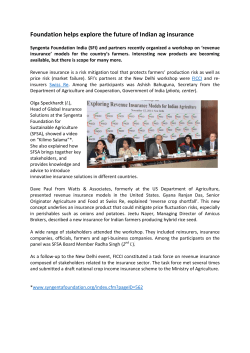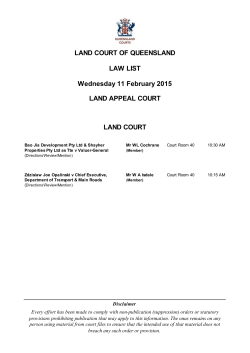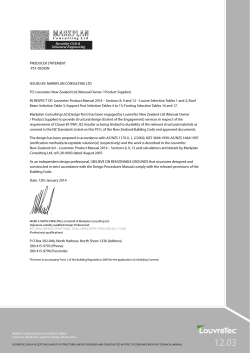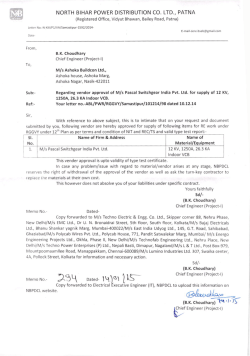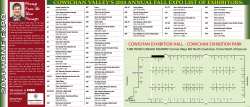
here - The Hale Group
The Digital Transformation of Row Crop Agriculture Iowa AgState Big Data Project Report December 12, 2014 LSC 800.229.4253 hale@halegroup.com www.halegroup.com Mapping Success in the Food System Discover. Analyze. Strategize. Implement. Execute. Copyright © 2014 by The Hale Group, Ltd. Sections of this Presentation No. Page 2 Section Title Page Numbers 1 The Situation Analysis 5–9 2 Company Positioning 10 – 21 3 Considerations for Strategy Development 22 – 30 4 A Farmer-Centric Strategy 31 – 45 Copyright © 2014 by The Hale Group, Ltd. LSC What is AgState? VISION STATEMENT Empower Iowans to lead the world in responsibly-produced food and agricultural products to not only meet, but exceed, the demands of customers. MISSION STATEMENT Dedicated to identifying challenges and opportunities in Iowa agriculture and recommending changes to help the entire state achieve the greatest possible benefit from Iowa's food, materials, and products industry. MEMBER ORGANIZATIONS Agribusiness Association of Iowa Dairy Iowa Iowa Cattlemen's Association Iowa Corn Growers Association Iowa Corn Promotion Board Iowa Department of Agriculture and Land Stewardship Iowa Department of Economic Development Page 3 Iowa Farm Bureau Federation Iowa Institute for Cooperatives Iowa Pork Producers Association Iowa Poultry Association Iowa Soybean Association Iowa State University College of Agriculture Iowa Turkey Federation Midwest Dairy Association Copyright © 2014 by The Hale Group, Ltd. LSC Task Force The consulting team was guided by a six member Task Force that devoted major amounts of time and invaluable insights into the project. Task Force members included: Ed Anderson, Iowa Soybean Association Brian Jones, Iowa Corn Dave Miller, Iowa Farm Bureau Federation Dean Lemke, Agribusiness Association of Iowa Kim Heckert, Iowa Institute for Cooperatives Dr. Matt Darr, Iowa State University This report is much stronger because of the many conversations, discussions, and debates with them. Page 4 Copyright © 2014 by The Hale Group, Ltd. LSC Motivation for this Project Iowa farmers have always been innovators in adopting new technology. During the last two decades, precision agriculture tools have been adopted by Iowa farmers with somewhat mixed success: – • Some tools being highly regarded as very useful; • Other tools providing minimal value to farmers.. During 2013-14, concern began to grow within farmer organizations about the use and potential misuse of farm data. The promise of Big Data in agriculture was alluring, but there was also concern about the potential downsides of the technology. Several farmer organizations in Iowa decided to ask AgState, as an umbrella organization for state-wide agriculture, to investigate the implications of Big Data for farmers. Page 5 Copyright © 2014 by The Hale Group, Ltd. LSC Purpose of this Project To develop the most appropriate strategy and tactics for row crop farmers to utilize Agricultural BIG Data to enhance the productivity, efficiency, and choices of American farmers while also protecting their farm data and intellectual property. Page 6 Copyright © 2014 by The Hale Group, Ltd. LSC Definitions Big Data: Data whose scale, diversity, and complexity require new architecture, techniques, algorithms, and analytics to manage it and extract value and hidden knowledge from it. Enterprise Agriculture: An integrated computer platform that includes: planning; agronomy; human resource management; work orders; purchasing systems; risk management; inventory management; logistics control; machinery maintenance; marketing; profit per acre. Digital Agriculture: A family of activities related to farming that includes Precision Agriculture, Prescription Agriculture, Enterprise Agriculture and depends on the collection, analysis and use of data from a multiplicity of sources with the goal of optimizing productivity, profitability and sustainability of farming operations. Advanced Farming: The research activities that are designed to advance Digital Agriculture to achieve improved productivity and sustainability over the long-term future, e.g., predictive phenomics. Page 7 Copyright © 2014 by The Hale Group, Ltd. LSC The Situation Analysis LSC Copyright © 2014 by The Hale Group, Ltd. Digital Transformation of Agriculture Past-Present-Future 5. System of Systems 3. Smart, Connected Product 2. Smart Product 4. Product System Weather Maps Weather Forecasts Rain, Humidity, Temperature Sensors Weather Data Application Weather Data System 1. Product Planters Farm Performance Database + Farm Equipment System + + + + Smart Tractors + Farm Equipment System Combine Harvesters Farm Management System + Cultivation Irrigation System Field Sensors Seed Optimization System Seed Database Seed optimization Application Irrigation Application Irrigation Nodes Source: Harvard Business Review, Michael E. Porter and James E. Heppelmann, November 2014 Page 9 Copyright © 2014 by The Hale Group, Ltd. LSC Key Data Challenges to be Resolved Tom Vilsack: “There are 3x farmers over 65 as under 35 today.” Human Capital: Farmers need to be Tech-Savvy and to have access to IT skills for use of data in decision making. Quality Data: The majority of Data generated currently is not useable due to poor quality, e.g., lack of calibration. Data Access: Much of the Data is on cards, sticks, hard drives or in binders of printed documents, and is very hard to access. Better Analytics are required to automate the analysis of imagery and maps. Agronomic Data held by Ag Retailers is not easily available for farmer use and aggregation in a broad manner. . Page 10 Copyright © 2014 by The Hale Group, Ltd. LSC The Adoption of Digital Agriculture: Enablers More Embedded Knowledge in the equipment, devices or systems required. Easy to use, intuitive, meeting expectations, e.g., iPhone. More Standardization across the vast range of products, services and systems being offered. Validation Processes for services offered and business models. Effective Security for data held both on-farm and off-farm. Technology Pull process that empowers farmers to define problems and influence innovation. User Training that works for the broad population of farmers. Attracting Data Scientists, Software Engineers and Computer Scientists to the sector. Page 11 Copyright © 2014 by The Hale Group, Ltd. LSC Summary of Write-In Comments from Electronic Survey Skeptical and/or Fearful of the New Technology – 65% The biggest concern is misuse of farm data by: • The ATPs • Activist groups • The government • Computer hackers • Grain traders 16% 19% 65% N = 95 Fear that it favors the large farmers. Prescriptions will recommend only some products, i.e., are biased. It doesn’t work. Agriculture is a complex biological system. Neutral or Nuanced in Attitudes – 19% It has potential, but must be implemented carefully. Embracing the New Technology – 16% The technology is here to stay. Let’s embrace it and make it work for us. No one that is highly profitable today is doing it with only their own ideas and crop data. Page 12 Copyright © 2014 by The Hale Group, Ltd. LSC Company Positioning LSC Copyright © 2014 by The Hale Group, Ltd. Technology Map The Technology Map is designed to present companies in the appropriate cells based on their offerings and position in the market. Products and Services Technology Drivers Precision Ag Equipment Data Warehouse Ag Retailer Software Smart Data Deterministic Models Probabilistic Models Farm Enterprise System Data Generation & Capture Cloud & Computer Processing Capacity Delivery Systems Source: The Hale Group, LLC and LSC International, Inc. Page 14 Copyright © 2014 by The Hale Group, Ltd. LSC Assessment of Key Players Completeness of Vision Ability to Execute Challengers Leaders • • • • • AGCO CaseIH Mapshots Raven Trimble • • • • • Deere & Co. Dupont / Pioneer Monsanto / TCC SST Software WinField / LOL • • • • • AgJunction AgLeader Conservis GeoVantage MyFarms • • • AGSOLVER Beck’s Hybrids Farm Link / True Harvest Niche Players Source: The Hale Group, LLC and LSC International, Inc. Page 15 Visionaries Copyright © 2014 by The Hale Group, Ltd. LSC Deere & Company: Backend and Frontend Software Cos. 100+ AgGateway 85+ Cos JD Link IT Staff of 600-800 API Developers John Deere & Co Dupont Pioneer Page 16 John Deere Dealers MyJohnDeere. com Growmark Farmers Copyright © 2014 by The Hale Group, Ltd. Dow Agro BASF BCS Ag Retailers LSC Dupont Pioneer: Backend and Frontend Farmer data via Deere DTN Pioneer Agronomy & Encirca Tech USDA & Universities AGCO & Raven Dupont Pioneer Encirca Sales Agents Page 17 Encirca. pioneer.com Farmers Pioneer Seed Agents Copyright © 2014 by The Hale Group, Ltd. LSC Monsanto-Climate: Backend and Frontend Climate Corp 2-300 IT staff Precision Planting Monsanto Seed Group AgGateway & OADA CaseIH Climate Corp. Helena GrowMark CPS Page 18 Climate Agronomy Reps Climate.com WinField LOL Farmers Copyright © 2014 by The Hale Group, Ltd. Crop Insurance Agents Ag Retailers LSC SST Software: Backend and Frontend SST Software 75-100 staff Data Warehouse AgX Platform Raven Slingshot AgGateway Co-op A Co-op B SST Software Ag Retailer A Page 19 Ag Retailer B Helena Crop Consultants Farmers Copyright © 2014 by The Hale Group, Ltd. LSC WinField : Backend and Frontend Climate Corp Geosys Answer Plot R7 Tool Answer Tech Winfield Data Silo AgGateway OADA WinField/Land O’Lakes Co-op A Page 20 Co-op B WinField.com Ag Retailer A Farmers Copyright © 2014 by The Hale Group, Ltd. Ag Retailer B LSC Establishing Value is a Challenge Unclear Value Clear Value Farmers need solutions with clear value. Tools Solutions • Auto steer • Variable rate seeding/fertilizer • Aerial imagery • Telematics • • • • • Yield maps UAVs Local weather Scouting apps Multi-hybrid planting Source: The Hale Group, LLC and LSC International, Inc. Page 21 • Current prescription models • Nitrogen management • Farm Enterprise System • Benchmarking Copyright © 2014 by The Hale Group, Ltd. LSC High Level Summary – Business Model The companies are attempting to use established business models for the type of service provided and/or models that are well established for other products in the ag sector. There is a great deal of experimentation currently and a common response is that “our business model is in a state of flux.” At the farmer level it is difficult to establish the value of the services being offered. Potential sources of value: Agronomic Value Operational Management Logistics Regulatory Compliance Information Sharing Crop Budgeting at sub-field level It is necessary to define value before sustainable business models can be established. Page 22 Copyright © 2014 by The Hale Group, Ltd. LSC Criteria to Evaluate Business Models Criterion Page 23 Evaluation Methodology • Economic Value Generated • Yield increase • Reduction of input costs • Other cost savings • Cost of the Product or Service • • • • • • ROI for Products and Services • DCF or economic payback • Transparency of Pricing • No hidden fees or costs • Standalone or Tied Product / Service Offer • Bundled / unbundled with other products or services. • Data Ownership, Use and Control • Farm data: Permission to share • Aggregated data: Farmer access • Vendor Independence • Product / service agnostic • Software approach by ATP • Closed proprietary or open source Subscription & software fees Cost per acre with a minimum. Share of value generated Share of yield per acre Investment amount Copyright © 2014 by The Hale Group, Ltd. LSC High Level Summary – Potential Economic Impact The “Innovators” indicate that using the best available Digital Technology in combination with high quality data it is possible to achieve a yield gain of 5-10 bushels of corn per acre. • At $3.50/bushel: Potential of $18-$35 per acre gross • Nitrogen Efficiency: Potential of $25-30/acre per beta testers. • Yield + input savings: Potential of $43-$65 per acre. • Less $3-10 per acre for ATP services: • Potential gain with current Digital Technology: $33-$62 per acre • These gains are in addition to savings from use of precision planting and application equipment. Page 24 Copyright © 2014 by The Hale Group, Ltd. LSC Considerations for Strategy Development LSC Copyright © 2014 by The Hale Group, Ltd. Overall Assessment This technology will continue to improve rapidly. Tech savvy farmers are already adopting it with enthusiasm. There is likely to be a major turnover in farm operators due to: • The current age of farmers. • The prospect of low crop prices for the next several years. The farmers that adopt this technology may have an advantage in renting land and will expand. There is a significant gap between those farmers who are prepared to adopt this technology and those who are skeptical and/or fearful. The farmer organizations and the ag retailers should assist their constituents in closing the gap. Page 26 Copyright © 2014 by The Hale Group, Ltd. LSC The Problems to be Addressed in the Strategy Unequal Market Power Farmers do not have equal negotiating power with major ATPs Information asymmetry puts farmers at a major disadvantage There are few places a farmer can turn for detailed information Complexity Farmers find the hardware, software, and business models hard to understand Hardware and software is not fully compatible across ATPs Many companies are marketing “tools” rather than “solutions” Legal Obstacles Some user agreements limit farmers’ choices Some legal documents are hard to understand Unclear Benefits There is a mixture of fact and hype in the marketplace The economic benefit of some products is not quantified Page 27 Copyright © 2014 by The Hale Group, Ltd. LSC Four Strategic Questions 1. Will all of the components of Digital Agriculture combine to create a major “inflection point” similar to the introduction of hybrid corn many decades ago? 2. Will Digital Agriculture Technology cause the row crop sector to become integrated, i.e., coordinated through contracts with farm operators by: • a few large ATPs, or • a handful of large corn and soybean customers? 3. How rapidly will consolidation occur within the row crop sector? 4. Will the sophisticated agronomy models allow computers to provide agronomic advice with little local agronomic input? All four questions are difficult to answer. We provide our opinions on the following slides. Page 28 Copyright © 2014 by The Hale Group, Ltd. LSC Incremental Change or Inflection Point Incremental Change Inflection Point 1 Years Page 29 • Not likely at this time since the value gain has not been established. • Given rapid changes in Digital Technology and the age profile of farmers an inflection is likely in the 2019-2023 period. • Most likely for the next 4 years since neither a dramatic breakthrough nor clear value have been developed as yet. • Most likely if the value created is at the current modest level of +/- 5%. 0 4 Copyright © 2014 by The Hale Group, Ltd. 8 LSC 2-a The Case for Integration by Major ATPs Likely Not Likely Major ATPs could help farmers use the new technology. Major ATPs already have a substantial integrated seed production system. The exit of older farmers will create opportunity for integration. Improving pork quality was part of the motivation for swine industry integration. ATPs do not have this motivation. The asset base for row crop production is much greater than for hog production. Volatility of crop prices would create huge risks for ATPs. At this time we believe full-scale integration by large ATPs providing agronomic prescriptions is not likely in the next 8 to 10 years. Page 30 Copyright © 2014 by The Hale Group, Ltd. LSC 2-b The Case for Integration by Major Customers Likely Not Likely Some farmers may need help using the new technology. Large corn and soybean users might fill the gap. The exit of older farmers will create opportunity for integration. Large feed, ethanol, soy processors, and other industrial users could control genetics and quality for greater product consistency and quality. Large independent farmers will resist such arrangements. Weather and the volatility of crop prices creates huge risks for integrators. If Prescription Agriculture produces only modest benefit. Integration by large customers cannot be ruled out if Prescription Agriculture is proven to be successful. Page 31 Copyright © 2014 by The Hale Group, Ltd. LSC 3 What Will Be the Rate of Farm Consolidation? Current Speed Accelerated Speed If adoption of Digital Agriculture is slow due to complexity human constraints. If the ATPs can’t demonstrate value. If the data security issues become more severe. Caps on total farm payments under Farm Bill may limit consolidation in low price environment. The prospect of low crop prices provides incentives to leave farming. Aging farmers retire and high tech, low cost producers capture land rentals. This technology is simplifying operations for large-scale farmers. Large farmers can hire people with specialty skills, e.g., IT and agronomy. The data privacy fears and concerns are mitigated through company action and experience. We believe that because of Moore’s Law, the technology will develop quickly and farm consolidation will accelerate. Page 32 Copyright © 2014 by The Hale Group, Ltd. LSC The Digitization of Agronomic Advice 4 How far will this trend go? Past Present Future Obviously the actual trend is not a straight line – the graphic is directional only. It’s too early to tell how far this technology will go. Page 33 Copyright © 2014 by The Hale Group, Ltd. LSC A Farmer-Centric Strategy LSC Copyright © 2014 by The Hale Group, Ltd. Mission of AgState Members for Digital Transformation To assist Iowa farmers during the Digital Transformation of Agriculture while fostering a business environment that is highly competitive and provides farmers with many business options. To assist Iowa ag retailers to: (1) capitalize on the new business opportunities; and (2) mitigate the threats to a strong rural business environment posed by Digital Transformation. Page 35 Copyright © 2014 by The Hale Group, Ltd. LSC Five Components of a Farmer-Centric Strategy A Farmer-Centric Strategy Education Assessment Data Warehouse Page 36 Technology Pull Copyright © 2014 by The Hale Group, Ltd. Research LSC Initiative #1 – Educate Farmers, Ag Retailers, Local Businesses, Policy Makers Provide continuous, on-going education for farmers, ag retailers, other local businesses, and policy makers that will enable them to make informed decisions: a. Distribute The Hale Group report. • Short and long PowerPoint presentations • Executive Summary Report • Short articles b. Conduct state-wide and regional workshops and webinars for farmers, ag retailers, and other businesses on Digital Agriculture: • Intensively in 2015 • Addressing new topics thereafter c. Provide the AgState Board with regular updates on the Digital Transformation of Agriculture developed for this project. Page 37 Copyright © 2014 by The Hale Group, Ltd. LSC Initiative #1 – Educate Farmers, Ag Retailers, Local Businesses, Policy Makers Provide continuous, on-going education for farmers, ag retailers, other local businesses, and policy makers that will enable them to make informed decisions: d. Create short videos on specific topics: • Provide short videos on a specific topic so farmers and retailers can learn and apply the knowledge immediately. e. Educate State and Federal policy makers • Provide timely information about Digital Agriculture to policy makers on any issues which affect farmers and the rural economy. Page 38 Copyright © 2014 by The Hale Group, Ltd. LSC Initiative #2 – Create a Grass Roots Data Warehouse Create an independent, farmer-controlled data warehouse for farm level data and aggregated agronomic data which can be used to better serve farmer participants. a. Develop guidelines for the ownership and use of data among land owners, farm operators, ag retailers and local businesses. b. Define the scope and scale of the agronomic data sets currently held by farmers, ag retailers and their software providers. c. Define the costs and capital requirements for the establishment of a cloud based data warehouse for farmers that is coordinated with ag retailers. Potential options include SST and Amazon Web Services. d. Evaluate business structures that would enable both farmers and ag retailers to collaborate in an independent data warehouse entity. Page 39 Copyright © 2014 by The Hale Group, Ltd. LSC Initiative #2 – Create a Grass Roots Data Warehouse Create an independent, farmer-controlled data warehouse for farm level data and aggregated agronomic data which can be used to better serve farmer participants. e. Develop a set of Privacy, Use and Control polices that fully protect the interests of the farmer while providing a high level of security. f. Establish the required API’s to facilitate access on a permission basis for trusted advisors and ATPs. g. Prepare a pilot program that could be tested in 2016 with at least several hundred farmers. h. Develop a strategy to optimize the value of local data if the results of the pilot project are positive and establish feasibility. Page 40 Copyright © 2014 by The Hale Group, Ltd. LSC Initiative #3 – Evaluate Products, Services, Business Models Create mechanisms to provide an assessment of the many products, services, and business models in the market while promoting uniform, agreed-upon industry standards and guidelines. a. Create a website where farmers share their assessment of specific Digital Agriculture tools similar to Amazon’s book evaluation. b. Create a mechanism for timely technical assessment for complex products and services similar to the Nebraska Tractor Test, Profi in Germany or Underwriters Laboratory. c. Engage with companies at early development stages so that the products launched receive early, practical feedback and reflect farmer priorities. d. Create a mechanism for estimating the economic value of products and services to farmers. Page 41 Copyright © 2014 by The Hale Group, Ltd. LSC Initiative #3 – Evaluate Products, Services, Business Models Create mechanisms to provide an assessment of the many products, services, and business models in the market while promoting uniform, agreed-upon industry standards and guidelines. e. Evaluate alternative business models used by industry participants in terms of clarity, benefits provided, and fee structure. f. Simplify the technology through collaboration with standards organizations such as AgGateway and OADA. g. Provide an assessment of the farmer-friendliness of legal documents used by manufacturers and service providers, by collecting, analyzing, and scoring the documents. Page 42 Copyright © 2014 by The Hale Group, Ltd. LSC Initiative #4 – Development of Farmer-Friendly Products and Services Drive a “technology pull” strategy focused on products and services that provide solutions to farmer problems rather than just complicated tools. a. Conduct focus groups and surveys to identify the key “pain points” for farmers which are not being addressed by the ATPs. • Farmers decide by electronic ballot what is most needed • Define categories of products and services of most interest for farmers. b. Conduct outreach to the Tech Community and ATPs so that the needs of farmers are understood and can be taken into account during the design and development phase for new products and services. c. Evaluate the potential for a “Challenge Award” process as a way to influence the direction of new technology development. Page 43 Copyright © 2014 by The Hale Group, Ltd. LSC Initiative #5 – Create an Institute for Advanced Farming Create a center for inter-disciplinary research that will position Iowa farmers to be at the cutting edge of digital technology for generations to come. a. Commence the Development of an Institute for Advanced Farming that would be based on the White House Policy to create six large Innovation Institutes in the Agriculture Sector using the public-private partnership model. Leadership by ISU. b. Define an inter-disciplinary research platform that includes Digital Agriculture, computer engineering, sensors, robotics, chemistry, genetics, genetic engineering, genomics, phenomics, and other non-traditional disciplines, supported by advanced simulation and predictive computer models. c. Conduct an Advanced Farming Workshop at ISU that would bring together all of the interested stakeholders from within the University and across the State of Iowa under the sponsorship of Dr. Steven Leath, President of ISU, Dean Wendy Wintersteen, and Secretary Bill Northey. Page 44 Copyright © 2014 by The Hale Group, Ltd. LSC Initiative #5 – Create an Institute for Advanced Farming Create a center for inter-disciplinary research that will position Iowa farmers to be at the cutting edge of digital technology for generations to come. d. Position the Advanced Farming Institute as the equivalent of the US Advanced Manufacturing Institutes which focus on the development of new opportunities in that sector. e. Obtain the support of the USDA and the active support of Secretary Vilsack for this initiative. This will require an updating of the PCAST study done in 2012 before the importance of the Digital Transformation of Agriculture became apparent. f. The Ag State members adopt a coordinated approach for this initiative and raise specific funding to support the development of an Institute at ISU. g. Obtain the support of the National Farm Organizations since the research conducted at the Institute will be applicable across the Midwest Region. Page 45 Copyright © 2014 by The Hale Group, Ltd. LSC Expected Timeframe to Realize Impact of Initiatives Planning & Funding Initial Operations Realization of Impact 1. Educate Constituents 2. Create Data Warehouse 3. Assess Products & Services 4. Create Technology Pull 5. Develop Advanced Farming Institute 2015 Page 46 2020 Copyright © 2014 by The Hale Group, Ltd. 2025 2030 LSC Annual Conceptual Budget Estimated Costs Initiative Launch Period Establishment Critical Mass Long-Term #1: Education • 2 FTE • $400K • 2 FTE • $500K • 2 FTE • $750K #2: Data Warehouse • 5 FTE • $1.25 MM • 10 FTE • $2.5 MM • 20 FTE • $5.0 MM #3: Technical Evaluation • 3 FTE • $750 K • 5 FTE • $1.25 MM • 5 FTE • $1.5 MM #4: Technology Pull Program • 1 FTE • $250 K • 2 FTE • $500 K • 2 FTE • $750 K #5: Advanced Farming Institute • 2 FTE-Core • $500K • 10 FTE-Core • $2.5 MM • $7.5 MM-R&D-Contract • 10 FTE-Core • $2.5 MM • $22.5 MM-R&D-Contract TOTAL: $/year $3.15 MM $14.75 MM $33 MM TOTAL: FTE 13 FTE 29 FTE 41 FTE Page 47 Copyright © 2014 by The Hale Group, Ltd. LSC Major Take-Aways Digital Transformation will create structural change in American agriculture. We’re in the 2nd inning. Farmers are still able to help shape the outcome. This project must now “pivot quickly” to include national organizations and other state organizations. The period between today and the hiring of full-time personnel to execute these initiatives is “the valley of death.” This is not the end. It is the end of the beginning. Page 48 Copyright © 2014 by The Hale Group, Ltd. LSC LSC Thank you 800.229.4253 hale@halegroup.com www.halegroup.com Mapping Success in the Food System Discover. Analyze. Strategize. Implement. Execute. Copyright © 2014 by The Hale Group, Ltd.
© Copyright 2025

